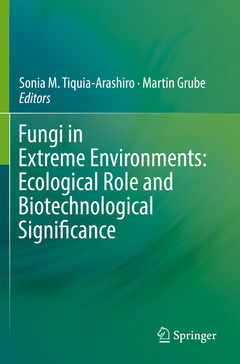Fungi in Extreme Environments: Ecological Role and Biotechnological Significance, 1st ed. 2019
Coordonnateurs : Tiquia-Arashiro Sonia M., Grube Martin

Over the last decades, scientists have been intrigued by the fascinating organisms that inhabit extreme environments. These organisms, known as extremophiles, thrive in habitats which for other terrestrial life-forms are intolerably hostile or even lethal. Based on such technological advances, the study of extremophiles has provided, over the last few years, ground-breaking discoveries that challenge the paradigms of modern biology. In the new bioeconomy, fungi in general, play a very important role in addressing major global challenges, being instrumental for improved resource efficiency, making renewable substitutes for products from fossil resources, upgrading waste streams to valuable food and feed ingredients, counteracting life-style diseases and antibiotic resistance through strengthening the gut biota, making crop plants more robust to survive climate change conditions, and functioning as host organisms for production of new biological drugs. This range ofnew uses of fungi all stand on the shoulders of the efforts of mycologists over generations.
The book is organized in five parts: (I) Biodiversity, Ecology, Genetics and Physiology of Extremophilic Fungi, (II) Biosynthesis of Novel Biomolecules and Extremozymes (III) Bioenergy and Biofuel synthesis, and (IV) Wastewater and biosolids treatment, and (V) Bioremediation.
Sonia Tiquia-Arashiro is an Environmental Microbiologist and a Professor at the University of Michigan-Dearborn. Her research focuses on microbial ecology, physiology and diversity, especially regarding the nitrogen cycle and biodegradation of environmental pollutants and the biotechnological applications of microorganisms. She served as Director the Master of Science in Environmental Science Program from 2011 to 2017 and currently serves as Chair of Microbiology at UM-Dearborn. She is the regional editor of the journal Environmental Technology and leads a large research laboratory with many undergraduate scholars.
Martin Grube is a professor at the Institute of Biologie, Graz, Austria. He obtained his Ph.D. in Biology from the University of Graz in 1995 for his work on taxonomy of tropical lichens and lichen-inhabiting fungi. He pioneered molecular phylogenetics of lichens and also studied of algal selectivity in lichens symbioses. Later he focused on the diversity and roles of bacterial communities in lichen symbioses. His research interests also include diversity studies of rock-inhabiting extremotolerant fungi, biological soil crusts, plant-associated microbiomes, and slime molds.
Date de parution : 08-2020
Ouvrage de 626 p.
15.5x23.5 cm
Date de parution : 08-2019
Ouvrage de 626 p.
15.5x23.5 cm



